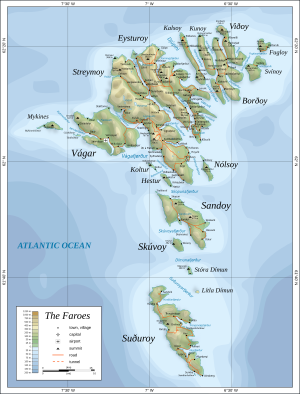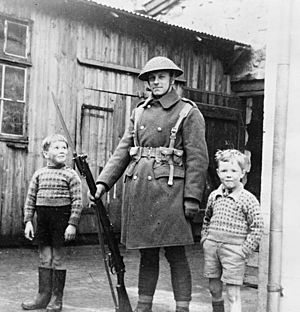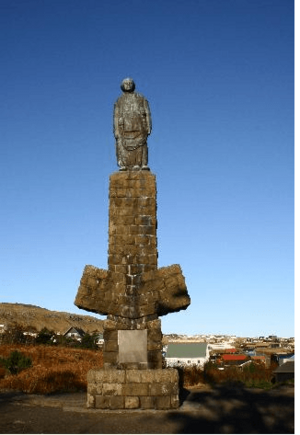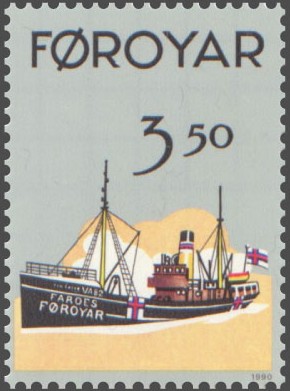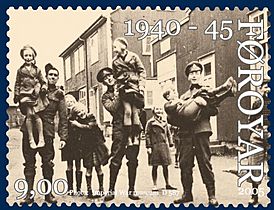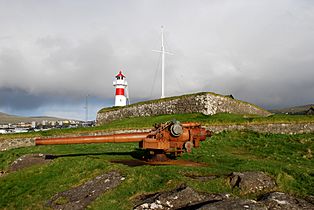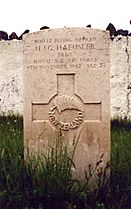British occupation of the Faroe Islands facts for kids
|
British occupation of the Faroe Islands
|
|||||||||
|---|---|---|---|---|---|---|---|---|---|
Quick facts for kids 1940–1945 |
|||||||||
|
Flag
|
|||||||||

Location of the Faroe Islands
|
|||||||||
| Status | Military occupation | ||||||||
| Government | Military occupation | ||||||||
| Historical era | WW2 | ||||||||
|
• Occupation
|
13 April 1940 | ||||||||
|
• Returned to Denmark
|
13 May 1945 | ||||||||
|
|||||||||
| Today part of | Faroe Islands | ||||||||
The British occupation of the Faroe Islands happened during World War II. It was also known as Operation Valentine. This event took place right after Germany invaded Denmark and Norway. It was a small but important part of the war in the Nordic countries.
In April 1940, the United Kingdom took control of the Faroe Islands. These islands belonged to Denmark. The British wanted to stop Germany from invading them first. British troops stayed there until shortly after the war ended in 1945.
Contents
Why Did Britain Occupy the Faroe Islands?
| Operation Valentine | |||||||
|---|---|---|---|---|---|---|---|
| Part of World War II | |||||||
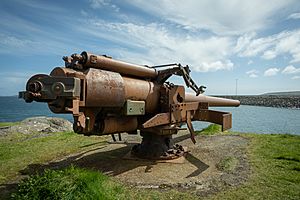 British Second World War naval gun, Skansin fortress, Tórshavn |
|||||||
|
|||||||
| Belligerents | |||||||
| Commanders and leaders | |||||||
| Strength | |||||||
| 8,000 troops | |||||||
| Casualties and losses | |||||||
| 0 | |||||||
At the start of the war, the Faroe Islands were a county of Denmark. On April 9, 1940, Germany invaded and took over Denmark. This made the British worry that Germany would also try to take the Faroe Islands. The islands were in a very important location in the North Atlantic.
To prevent this, the British launched Operation Valentine. On April 11, 1940, Winston Churchill, who was a top British leader, announced the plan. He told the British Parliament that they were occupying the Faroe Islands. He said the Faroese people seemed happy to have them. Churchill promised to protect the islands from the war. He also said they would return the islands to Denmark once it was free from German control.
British Troops Arrive
On April 11, the British ship HMS Suffolk set sail for the Faroe Islands. It carried 13 officers and 180 Royal Marines. They also had two large howitzer guns. Two destroyers, HMS Havant and HMS Hesperus, escorted the ship.
The British Broadcasting Corporation (BBC) announced the occupation on the radio. A British Royal Air Force (RAF) plane was seen over Tórshavn, the capital. On April 12, the two destroyers arrived in Tórshavn harbor.
British officers met with Carl Aage Hilbert, the Danish leader of the islands. They also met with Kristian Djurhuus, the head of the Faroese parliament, called the Løgting. The Løgting held an emergency meeting. Some members wanted to declare the Faroe Islands independent. However, their idea was voted down.
An official announcement was made about the occupation. It ordered a nighttime blackout in Tórshavn. It also said that mail and telegrams would be checked. Driving cars at night without permission was also forbidden.
On April 13, the larger British ship HMS Suffolk arrived. Colonel T. B. W. Sandall, the British military commander, met with the Danish leader. The Danish leader formally protested the occupation. But he also accepted the British terms. This was because Denmark itself was occupied by Germany.
The British promised not to interfere with the islands' daily life. The Løgting also made a formal protest. However, they still wanted friendly relations with Britain. The Royal Marines were replaced by Scottish soldiers called the Lovat Scouts on May 27. Later, in 1942, another Scottish regiment, the Cameronians, took over. By 1944, fewer British soldiers were needed.
Swedish Ships Incident
On June 20, 1940, six Swedish Navy ships arrived in the Faroe Islands. Sweden was a neutral country, meaning it was not fighting in the war. Four of these ships were destroyers that Sweden had bought from Italy. They were on their way to Sweden. The other two were a passenger ship and a tanker.
The Royal Navy seized all these Swedish ships. They moved them to Orkney, an island group north of Scotland. Britain was worried that Germany might capture the ships if they continued to Sweden. After some talks between the two countries, Sweden got its ships back. The British had removed some equipment and damaged the ships. Britain later paid Sweden for this damage.
Life During the Occupation
The Faroe Islands were sometimes attacked by German planes. However, Germany never tried to invade them. A big problem was floating sea mines. These mines caused many fishing boats to sink and their crews to die. For example, the trawler Nýggjaberg sank in 1942 near Iceland. This killed 21 Faroese sailors, the biggest loss of Faroese lives in the war.
Faroese ships had to fly the Faroese flag. They also painted "FAROES" or "FØROYAR" on their sides. This helped the British Navy know they were friendly ships.
To control prices, Danish money on the islands was stamped. This showed it was only valid in the Faroe Islands. The Faroese money was linked to the British pound. New Faroese banknotes were even printed in England.
Self-Government and Aftermath
During the occupation, the Faroese parliament, the Løgting, gained more power. They could make their own laws. This happened because Denmark was occupied. In 1944, Iceland became an independent country. However, Churchill did not want the Faroe Islands to change their status while Denmark was still under German control.
After Denmark was freed and World War II ended in Europe, the British occupation ended in May 1945. The last British soldiers left in September. The experience of governing themselves during the war made the Faroese people want more control. They did not want to go back to being just a county of Denmark.
In 1946, the Faroe Islands held a vote on independence. This led to them gaining more self-rule within Denmark in 1948.
Lasting Reminders
The biggest sign of the British presence is the runway at Vágar Airport. British engineers built it during the war. Other reminders include naval guns at Skansin fortress in Tórshavn. This fortress was the British military headquarters.
The Faroese people also developed a love for British foods. These include fish and chips and British chocolate. A health study looked into changes in health among the Faroese after the war.
In 1990, the Faroese government held "British Week." This celebrated 50 years since the friendly occupation. A British warship and a Royal Marines band attended. Sir Frederick Mason, who was the British consul during the war, also came.
Faroese Lives Lost
More than 200 Faroese sailors died at sea during World War II. Most of these deaths were due to the war. A monument in Tórshavn's park honors them. German submarines or floating sea mines sank several Faroese fishing boats. Faroese fishing vessels caught fish near Iceland and the Faroe Islands. They then took their catch to the UK to sell.
British soldiers also died. For example, five out of six crew members died in a British RAF plane crash on November 9, 1942.
Vágar Airport
The only airfield in the Faroe Islands was built in 1942–43. It was built on the island of Vágar by British engineers. Most British soldiers in the Faroes were stationed at Vágar. They mainly worked on building the airfield.
After the war, the airfield was left unused. It reopened in 1963 as the civilian Vágar Airport. Interestingly, cars drove on the left side of the road on Vágar island until the British troops left.
The Faroese Flag
After Germany occupied Denmark, the British Admiralty no longer allowed Faroese ships to fly the Danish flag. This was a big problem for the Faroese economy. Fishing was very important to them.
After many talks, the British authorities recognized the Faroese flag – Merkið – on April 25, 1940. This meant Faroese ships could use their own flag. This allowed them to continue their vital fishing trade.
Gallery
-
2005 Faroese stamp commemorating friendly relations between British soldiers and the Faroese
-
British Second World War naval gun, Skansin fortress, Tórshavn
See also
- British invasion of Iceland
- Politics of the Faroe Islands




